Update for May, 2018: Spring is here. The global vibe I’m getting for late April and early May weather is “unpredictable” – wild temperature swings, unseasonable cold snaps, unseasonable heat, general weirdness. The atypical seems to be getting pretty typical.
Fortunately, our mild maritime Northwest climate continues to be a bit more restrained. The big thing I’m noticing this May is a lack of typical levels of rainfall. It’s not really common to get multi-day stretches of clear weather this time of year, but that seems to be what we are looking at.
If natural, gentle, regular sprinkly rains don’t return, keep a close eye on your garden’s irrigation needs. Be especially mindful of new transplants and newly sown seeds, which won’t have the root mass yet to tap into the moisture that is still deeper in the soil.
It’s always folly to try to predict the weather, but I have a very positive gut feeling about this year for our fruiting, heat-loving crops. Although I wilt anytime the temps climb past 78, the summer crops of tomatoes, peppers and squash love long, hot days, and I think we will see plenty of them this summer. My guess is we will have a greater-than-average number of days in the 80s.
The big tasks this month are direct seeding nearly everything, and transplanting out your previously-started warm weather crops.
Watch the overnight lows; once your location is reliably above 50 at night you can move your hardened-off tomatoes outside. Since it’s not unusual for overnight lows to hover around 50 well into July, a little protection in the form of a low tunnel or wall-o-water type season extender will really help your warm weather crops thrive through cool spring evenings.
Read on for the giant list of everything to do in May, along with my convenient, printable, At-A-Glance Grow Guide. As always, keep your local microclimate and seasonal variations in mind, and adjust timings as needed.
Printable At-A-Glance Grow-Guide!
If you like your Gardening To Do Lists simple and direct, you’re in luck! Just click the image below to download the May At-A-Glance Grow Guide in PDF. Or, continue reading for the full details on everything you should be doing in your garden this month.
Plan and Purchase
Warm season edibles like tomatoes, peppers, beans, eggplant, melon, cucumber and corn are in the nurseries, outside of grocery stores, at farmer’s markets and pretty much everywhere now.
But wait….STOP!

Just because you can buy it does not mean you should, or that it’s ready to be transplanted out. Your marching orders for seedling season:
- No crappy seedlings.
- No Big Box starts. Go with locally grown seedlings – they are more likely to be varieties that will thrive in your backyard, and they are less likely to introduce new diseases to your garden.
- Harden off seedlings before you give them a space in your garden. Assume all seedlings you purchase today were living in an 80 degree greenhouse yesterday and transition them gently.
- Watch your overnight lows and be prepared to protect tender transplants against sudden drops in temperature.
- Smaller plants establish and transplant better than older ones, so go with the 4″ tomato instead of the gallon. They’ll catch up, don’t worry.

Start thinking about the fall garden. No, you don’t have to do anything yet, but just keep it in the back of your head that many of the fall and winter crops like Brussels Sprouts and some of the long-season cabbages mature veeeeerrrrry slowly, and will need to be started in late June or early July to give you a satisfactory harvest.
Make sure you have what seed you’ll need and that some space in the garden beds will be available when the time comes. (Learn More: How To Make Succession Planting and Year-Round Gardening Really Work.)
Start Indoors
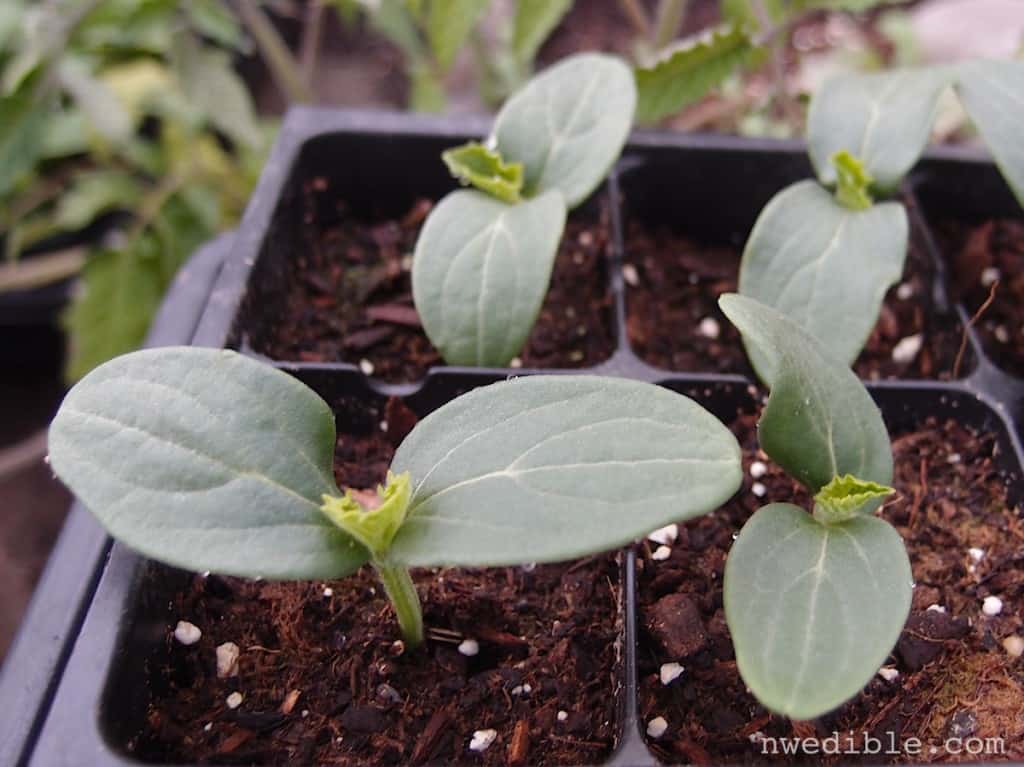
At this point everything can be sown out directly, which is less work and energy than starting crops indoors. But you may still prefer to get some crops going under lights, or in small pots in the greenhouse or cold frame, to have at the ready.
The biggest reason I give some of these warm-season crops a head start under lights is because I’ve had too many rows of just-germinated cucumbers devoured in a single night by slugs. I’ve lost entire rows of beans this year to the slugs and I’m not happy about it. (Sluggo and ducks are the only thing I know that really helps control slugs.)
That said, nothing in the curbit (squash) family really loves being transplanted, so don’t let those crops languish in pots too long before transplanting.
Cucurbits
These tender melon-family babies can still be started indoors, but don’t delay – if you start them today, they will be happy 3 or 4 week old transplants at the end of May or beginning of June. Don’t try this with super-long season winter squash, but the fast growers like zucchini and cucumbers still have plenty of time.
- Cucumber
- Melon
- Pumpkins
- Summer Squash
- Winter Squash
New to starting your own seeds? Here are some resources to help:
- Seed Starting 101: Key Components For Healthy Seedlings
- Seed Starting 101: A Step-by-Step Visual Guide To Growing Seedlings At Home
- Seed Starting 101: Up-Potting
- Seeds Started Under Lights vs On A Windowsill
- Which Seed Starting Supplies Are Worth It (And Which Aren’t)
- My current T5 grow light which I love
- The inexpensive LED grow light I’m trialing this year
Leafy Greens and Herbs
At this point I think you might as well direct sow these outdoors, but if you want, you can start inside:
- Basil – Always more basil! Start a lot – it’s not too late. It’s basil, the Queen of Herbs!
- Swiss Chard
- Salad Greens – only heat tolerant varieties at this point. Think romaine, not spinach.
- Hardy Herbs – Think parsley, chives, fennel, chervil, oregano, dill, mint, sorrel, marjoram, lemon balm, pansies etc.
Other Stuff
- Corn – you can start this inside. It actually works pretty well. Make sure you start enough though – you want blocks of corn stalks at least 4 by 4 for good wind pollination, so you’ll need a minimum of 16 seedlings, and I’d recommend twice that.
Sow Directly & Transplant Out
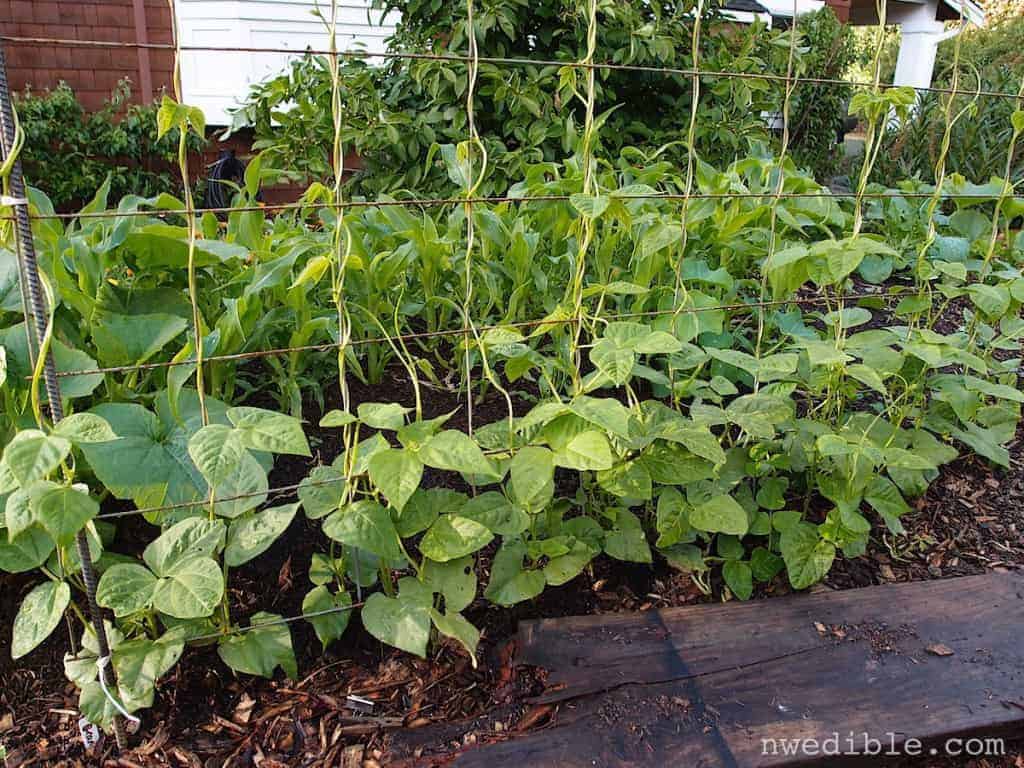
If your soil is warm and you don’t have a massive slug problem, you’ll get the best results with many of summer’s favorite veg by direct seeding.
By mid-May it’s typically safe to direct seed beans, squash, cucumber and corn. Check for warming soil temps and overnight lows consistently in the mid-to-high-50s or above: these are what determine if your seed will germinate rapidly and grow happily, or will languish and potentially rot.
Need to give your warm-weather crops a heat boost? Direct sow heat lovers like corn and squash under vented clear plastic or mini-bell cloches made from old milk jugs and and rely on the increased temps to give you strong and early germination. Just be careful temps under a cloche don’t get so hot that you cook your seeds or newly germinated seedlings!
This is a great month to get the kids involved – the large seeds of beans and squash are easy and fun for kids to sow. (Read more: The 5 Best Vegetables To Grow With Kids.)
Brassicas
In the Pacific Northwest, brassicas do very well as a year round crop, so if you want a nice continual harvest of broccoli and cabbage, consider a May sowing in addition to the big April transplanting.
The important thing if direct sowing these crops is slug protection. Again, Sluggo. Use it. Transplants can also fall victim to those damned mollusks, so be on the lookout (preferably at night, with a sharp pair of scissors in hand.)
- Broccoli
- Cabbage (early types)
- Cauliflower (early types)
- Collards
- Kale
- Kohlrabi (spring types)
Cucurbits
If you prefer direct seedling over starting these indoors, go for it! Just (again, again, again) watch for slugs who think cucurbit cotyledon are the most delicious things ever.
- Cucumber
- Melon
- Pumpkins
- Summer Squash
- Winter Squash
Nightshades
Over the course of this month, all the nightshade crops can be transplanted out. Watch overnight lows in your particular garden to help decide when the time is right, and how much protection to give them.
- Eggplant
- Peppers
- Tomatoes
Legumes
All beans can be direct seeded this month with great success.
- Bush snap beans – Hard to go wrong with Provider. Fast and dependable.
- Pole beans – Scarlet runner is the most cool-night-tolerant bean I grow, and the Romano types are my favorite for all around fresh eating and freezing.
- Dry beans – I am in love with Calypso for this area.
Roots
These can all be sown at any time. Just make sure your soil is dry enough to rake to a fine tilth. Roots do best in deep, fluffy soil.
- Beets
- Carrots
- Parsnips
- Potatoes (short season types)
- Radishes
- Scallions
Harvest
Serious fresh eats! May is the month when eating from the garden can start to happen with abandon, and marks (for my family) the end of nearly all shop-bought produce for 7 or 8 months.
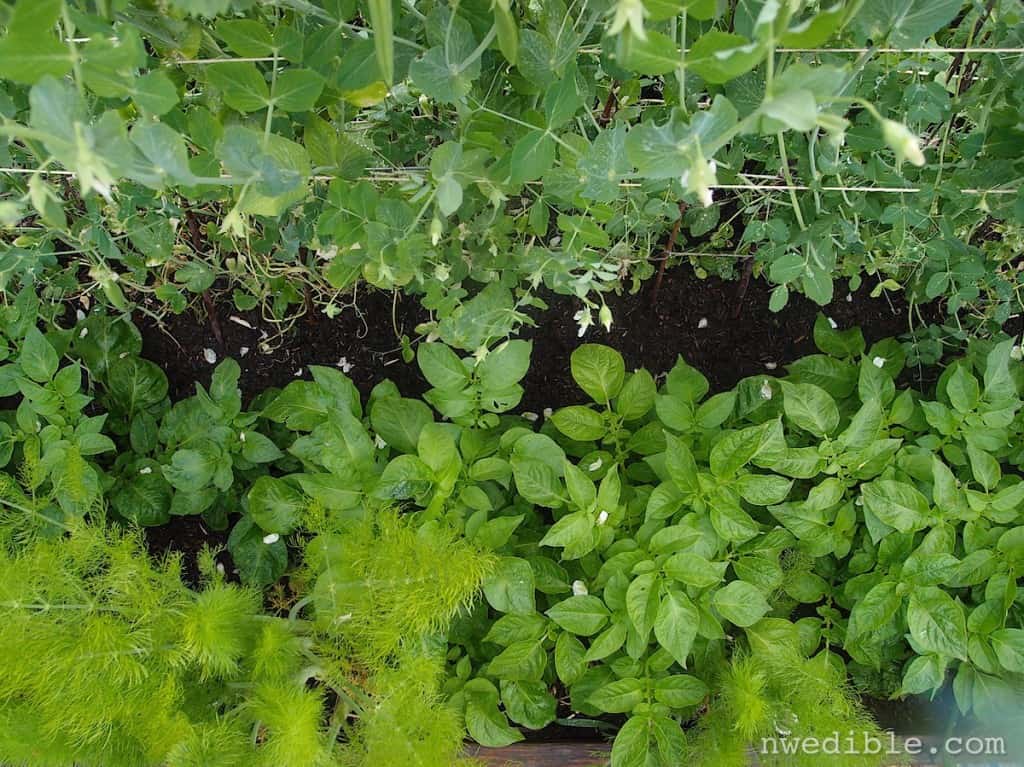
- Salad Greens – lettuce, spinach, mustard greens, radish greens and more!
- Broccoli – Yum!
- Spring cabbages – with luck these will be ready towards the end of the month.
- Overwintering leeks and green garlic
- Rhubarb
- Asparagus – An established patch will still be harvestable.
- Spring cauliflowers – The earliest cauliflowers should be ready in late May.
- Kale – Prime in baby-leaf stage, or sprouts from last years plants.
- Chard – Overwintered chard is still churning out leaves.
- Peas – harvesting peas in May is possible if you started peas in a length of guttering and the weather cooperates!
How’s your May garden blooming?
Pin for Later or Share with a Friend
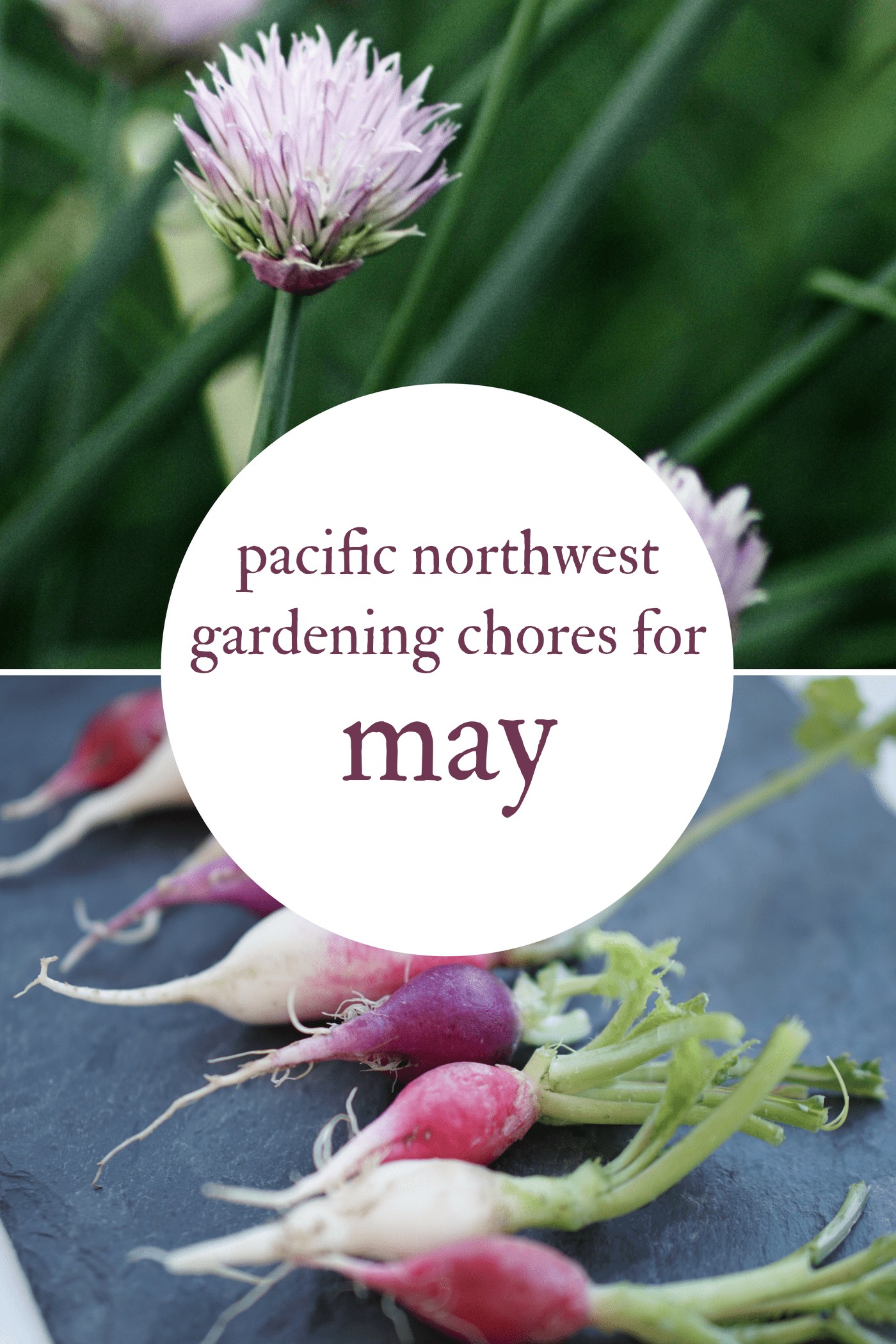
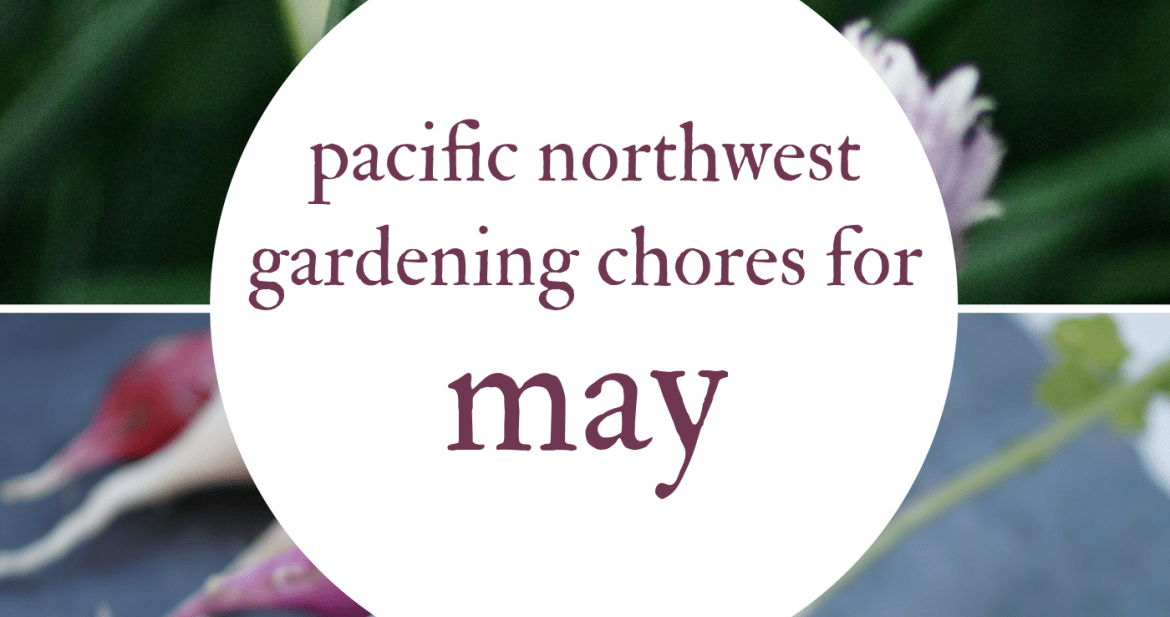

Just curious – in your May “to-do” calendar you said (re starting cukes, squash etc. inside): “Don’t try this with super-long season winter squash”, and I’m wondering why not? I’ve always started all my squash inside and transplanted them gently. I’m up by the Canadian border and our growing season is a bit shorter than yours…
Oh, I probably wasn’t clear – I didn’t mean ALL winter squash. The winter squash that will fully ripen by the time frost comes are still fine to start indoors. But if folks are just now starting winter squash, I’d suggest more fast-maturing varieties at this point. I wouldn’t count on only squash with a catalog 120+ day maturation at this point, in other words.
Ah, thanks, got it. In general I aim for squash that mature in under 100 days, so I’m thinking I’m safe.
And your At-A-Glance calendars are VERY helpful!
Hey Erica,
Haven’t read the whole post yet (supposed to be working), but I just wanted to say that I really like the At-A-Glance guide. April’s prompted me to get out there and get some things planted and I’ll be continuing with some things I see on May’s list this next weekend.
Barb
Thanks Barb!
My prbloem was a wall until I read this, then I smashed it.
I love deadlines. I love the sound as they go whooshing by. – Douglas Adams
Definitely in the land of having done so much work with so little discernible progress.
If I had to be an actual homesteader, my family of one would starve.
That’s one of my favorite quotes.
“My preferred method to direct sow heat lovers like corn and squash is to plant these crops under vented clear plastic and rely on the increased soil temp to give me strong and early germination.”
This is a great idea! By “vented” do you mean you just poked some holes in it? Or is that a different kind of plastic from the generic clear plastic I have laying around?
I assume she means an open ended cloche. That is what I do. And yes, it works wonders. Just use some sort of hoop type support to support the clear plastic… I have used wire, pvc, and bent electrical conduit… Anything that works. Leave the ends open so that it does not overheat.
Ok, thanks! I had imagined something closer to the ground, but what you’re saying would be more practical (e.g. it could also cover plants during the winter). I guess that will be my next garden constructions project…
I finally, finally, finally have a garden again, zomg!!!
I’m a little excited, can you tell? 😉
Summer seems to have arrived a few weeks early up here, but I’m taking the chance and planting stuff as I go. So far I have planted (as seeds):
Red Russian Kale
Rappini
Rainbow Chard (so much rainbow chard)
Snow peas
Sugar/snap peas
fava beans
musquee de provence (pumpkin)
marina di chioggia (winter squash)
Canada crookneck (winter squash)
Dill
Borrage
Cilantro
AND (as starts)
Sweet basil
Greek oregano
Sage
Winter savoury
Lots of Vietnamese garlic (transplanted from the yard, and hoping it’ll spread)
Strawberries (two “four season” plants – whatever that means – which I’m hoping will spread as well)
I also planted half a dozen jerusalem artichokes (we’ll see if they sprout – they were from a grocery store) and am hoping to add a rhubarb cutting from my in-laws’ back garden later this summer. The goal is to turn one of the garden beds into perenial edibles and have the other (and the two more that will, here’s hoping, get built next spring) be for annuals.
Now I’m waiting to see what sprouts (some of my seeds are almost three years old, so we’ll see…) and I’ll fill things in as needed.
Still to plant:
From starts: Tomatoes, cucumbers, golden zucchini, maybe an eggplant, may or may not try ground cherries again this year
From seed: Various pole beans, maybe a second cucumber plant, extra winter squash depending on how many of my 15 seeds actually germinate and grow.
My peas and rapini (and maybe some of the kale?) are already starting to germinate and poke their noses above the soil, so I’m just ridiculously chuffed about the whole business. 😉
I sewed lots of the recommended seeds outdoors in March and April, and my seeds germinated great, but then completely stopped growing. They are starting to die now- turn yellow, get eaten, just generally failing to thrive. I have no idea what’s wrong. I am using purchased garden soil amended with fertilizer and compost. I had them covered in white garden cloth, but I came home a few weeks ago and the whole garden was full of a brown curly fungus/mushroom, so I removed the cloth to discourage the mushrooms, which are gone now. I hadn’t been watering because my problem had been that the garden was too wet, but now the soil has dried more, so I have watered the last two days, and then today it rained. The soil is very dense- it dries into a hard crust on top, so I sprinkled a mixture of sand, fertilizer, charcoal and manure on top, but I can’t work it into the soil and disturb the tiny seedlings. I’m almost tempted to destroy them at this point and start over with bought starts, but I’m concerned I’ll just have the same problem. Could you write more about caring for seeds planted outdoors or point me towards previous articles? I can’t find any advice for what to do in this situation.
I love your monthly gardening to-do lists. It always reminds me to JUST PLANT MORE. However, slugs, I am going to have to figure out something to do with….
Have you seen the tomato/pepper/vegetable starts at Costco this yearr? I was surprised to see that my local Costcos are both carrying locally-started tomatoes and peppers — within 100 miles of one of them, and about 120 from the other. I was shocked/not shocked because Costco is getting cooler and cooler these days.
I sadly screwed the pooch on my cucurbits and started them inside way too early, so I’m going to see what direct seeding luck I get. We’ll see.
We live at the edge of the wilderness in the Upper Skagit Valley, where we receive way, way more rain and snow than Seattle does. It has been a #%&! – ing winter and spring, I tell you that. I am so ready for sun.
My goats are grumpy, and so are the chickens, although the ducks love the wet. Me? I am very, very grumpy about this weather.
Fortunately, my garden is almost planted, because I have awesome soil that drains amazingly. I’ve improved it organically for 14 years, and it shows.
I basically ran outside the two days it didn’t rain in the past two months, broad forked the garden, weeded and planted like a lunatic.
At least the buttercup comes out like butter in this wet weather…
That convergence zone, right? 😀 Well-draining soil is worth its weight in gold right now!
Tomato question – I have a small P-Patch plot in Seattle, and it’s currently jam-packed with chard and peas that are still just a few inches high. All the local garden sales start up next weekend, and my plan this year is to go for broke on tomatoes, tomatillos, and peppers, but I don’t know where to put those tomatoes while I’m waiting for spring crops to come in. Any suggestions? Will they be OK in pots for a month or so, or should I find a place to plant them in the garden now? Or just wait until later in the month and take my chances on what’s left in stores?
You’ll have better luck if you plant when soils and overnight lows are warmer. Unless you can really tend them with cloches and stuff, it’ll probably be easier to keep them happy in pots, hardening them off slowly by moving them outside more and more during the day and bringing them in at night. All those nightshades can be up-potted repeatedly as needed. Keep an eye on the roots to know when it’s time to give them a bigger pot. If you get smaller, determinate/bush types you can even take them all the way to harvest in a big (5 gallon minimum) pot.
Thanks, Erica! That is super helpful!
I cannot tell you how excited I was to see this post this morning. I may have actually squealed. I’m just about a forty minutes north of Seattle, and I’ve never seen my soil this wet. Ever. Nor have my cold-hardy salad greens taken this long to germinate. So frustrating! I’ve been delaying starting my cucurbits under lights because I remembered what you said about starting them around three weeks before they get transplanted out, and I just keep waiting and waiting for those nighttime temps to get reliably in the 50s. So far, they’re still often in the low 40s. Uuuuuugh. And the salad mix I started in February and then transplanted out in March bolted before they ever got bigger than baby greens. Le sigh.
Thanks Rebecca. Good on ya for waiting on the cucurbits – stuff like cucumber and zukes will “catch up” anyway when the weather is right. They only thing I might start asap is long-season winter squash because it’ll need all the summer we can give it to ripen properly. If you’re careful you can transplant big cucurbits from gallon-size pots. It’s just important to transplant delicately and before they fully fill out their pot.
I just planted a lot of my seeds in pots two days ago, have them in a small greenhouse, first time doing this. I put in tomatoes, squash of different kinds, cucumbers, and peppers, crossing my fingers due to the weather
Just found your posting on Cloches and shared it on FB. Nice blog and great tips. I have a 10 x 40 community plot in Portland OR and will share with the other gardeners. I’ve been building cloches for years but never thought to use the four way connectors to shore up the middle (usually I put some additional diagonal posts on the end).
I also tended to use 3 mm opaque sheeting and it did go bad after a few years. Not sure I’m ready to invest yet in the 6mm greenhouse sheeting, but just ordered a roll of 4mm clear for my tomato cloche. They’ve been in teh ground for a week and are doing fine but we’re having a run of sunny days and I’d like to get them some addtional rays!
Thanks for stopping by, Paul! Appreciate the share and good luck with your tomatoes!
I discovered copper tape last summer and my slug problem is gone. I have raised veggie beds edged with 2×10 lumber…I attached the Cory’s copper slug tape with copper tacks to the top edge… it comes with adhesive on the back but that only holds long enough to install it. Slugs will not cross the tape. The trick is to make sure you are not trapping slugs in your garden bed….
fantastic and wonderful!
Gosh, Erica, I’ve read your blog for years and I can never get over how organized you are!
I’m also going to be experimenting with repotting nightshades as I’m attempting to grow one tomato plant in a pot so that I can overwinter it in my greenhouse and get tomatoes through December. I have done it a couple times before at a different house. We’ll see how it goes. Thanks for all of your info, cheers.
It’s great to have a checklist like this to go through your to-dos in the garden. You never know what you’ll forget. Thanks for sharing